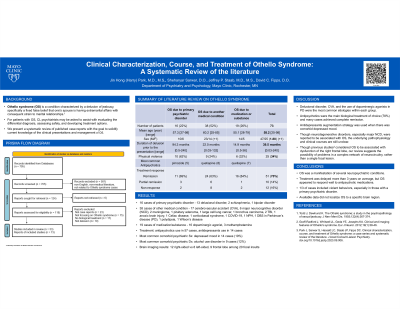Neurocognitive Disorders, Delirium, and Neuropsychiatry
Session: Poster Session
(089) Clinical Characterization, Course, and Treatment of Othello Syndrome: A Systematic Review of Case Reports

Trainee Involvement: Yes

Jin Hong Park, MD (he/him/his)
Resident physician
Mayo Clinic
Rochester, Minnesota, United States- SS
Sheharyar Sarwar, DO (he/him/his)
Associate Consultant
Mayo Clinic
Rochester, Minnesota, United States .jpg)
David C. Fipps, DO
Assistant Professor of Psychiatry
Mayo Clinic
Rochester, Minnesota, United States
Presenting Author(s)
Co-Author(s)
Background Othello syndrome (OS) is a delusion of infidelity characterized by fixed false beliefs that one's spouse has extramarital affairs with high risk of violence and limited insight (Todd, 1955). Consultation liaison (CL) psychiatrists are often requested to assess patients with OS considering the common overlap with other medical conditions. Objective This study’s objective was to characterize the clinical presentations of OS and solidify current knowledge in regards to assessment and treatment of OS through a systematic review of case reports. Methods A literature search was conducted by a medical librarian from the start of the databases through August 2022. English language case reports of adults (≥18 years) with OS and subsequent biological treatment were included. Age, sex, proposed etiologies of OS, treatments of choice, response to treatment, duration of delusions, comorbid psychiatric symptoms, neuro-radiographic findings, and presence of physical violence were extracted. Results 673 abstracts were screened, 113 articles underwent full-text review, and 73 cases (from 1983-2022) met the final inclusion criteria. Mean age was 58.2 years with male predominance (M:F = 1.88). Proposed etiologies were classified into three groups: primary psychiatric disorders (21.9%), another medical condition (AMC) (52.1%), and medication/substance induced (26.0%). Delusional disorder, stroke, and dopaminergic agonists were the most common etiologies in each respective group. Antipsychotics were the most common treatment of choice (78.1%). Symptom remission was reported in 69.9% of cases. The average duration of OS was 39.5 months. Of the cases reporting brain imaging insults, 60.0% were right-sided and 40.0% were left-sided with the most common focal insults occurring in the frontal lobe (45.0%). The most common psychiatric symptom was depression (19.2%), and 34.2% of cases reported violence. Discussion Our results indicate that other medical conditions and medication/substance related presentations represent the majority of OS cases- with strokes and dopaminergic agonists being the most common causes. Though the right frontal lobe has been previously implicated in OS pathophysiology (Graff-Radford, 2012), our results demonstrated a more broad variety of focal findings. The majority of OS cases achieved remission with antipsychotics. Antipsychotic choices predominantly reflected pertinent comorbidities and the potential for side effects rather than potency. Conclusions OS presents with a variety of neuropsychiatric conditions, and it is likely that no single brain region represents the underlying etiology. Antipsychotics are an efficacious treatment option. Future research can further expand the understanding of OS pathophysiology and treatment options. References TODD J, DEWHURST K. The Othello syndrome; a study in the psychopathology of sexual jealousy. J Nerv Ment Dis. 1955;122(4):367-374. Graff-Radford J, Whitwell JL, Geda YE, Josephs KA. Clinical and imaging features of Othello's syndrome. Eur J Neurol. 2012;19(1):38-46.

